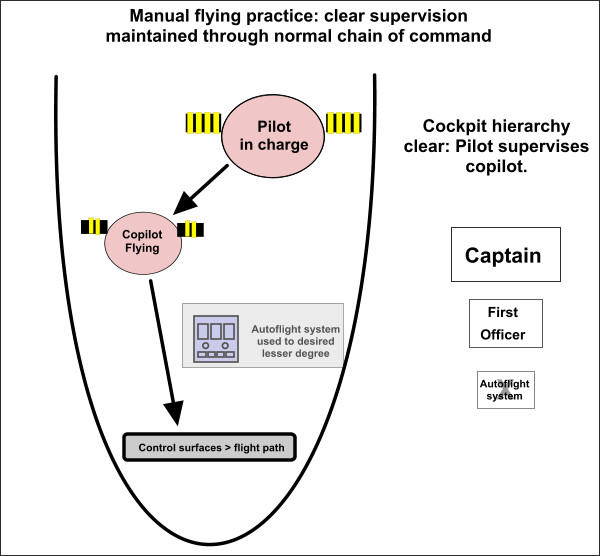"Automation is safer and cheaper, so how we can allow manual flying ?"
Where managements need to deal with the dilemma of "autoflight is safer - but manual flying is still needed", the use of PicMA procedures as standard could provide a solution. Manual flying for pilot practice and familiarity provides a long term safety benefit, but it needs to be done in benign conditions, when the notional reduction in safety levels of not using the automatics can be balanced against the greater error tolerance of having fewer threats.

Even so, this may not be acceptable to many managements, unless additional safety measures are put in place. The demonstrated greater effectiveness of monitoring using PicMA is exactly the sort of additional precaution needed. For example, during a normal sector in benign conditions the Captain would have good visual cues, etc., and plenty of "spare capacity".
Under these circumstances the First Officer could safely concentrate on flying a MANUAL instrument approach, in the full knowledge that the Captain will be taking control himself either approaching DH/DA minima, or at a higher altitude and with full visual reference, in the event that the F/O experiences difficulties.

Practice for both pilots.
While this might at first sight appear to refer only to the First Officer getting significant manual instrument flight practice, the reverse would also of course apply during a First Officer's sector, when the Captain can get manual flying practice. As we've seen in the section on "benefits in all cultures" this also gives an incentive to Captains to allow First Officers practice at takeoffs and landings.
These practices help maintain the essential basic handling skills that many pilots, manufacturers and regulatory authorities are concerned are now being eroded by an overemphasis on the use of all available automatics on all possible occasions. Emphasising that this is a permitted deviation from the default SOP, but is always at the Captain's discretion, leads to an increased alertness of all crew members to the need for vigilance.
Automation and Captain's discretion.
Manoeuvring the aircraft, especially hand flying, is one of the most enjoyable experiences imaginable - and that is why so many pilots, especially Captains, are reluctant to accept the concepts of PicMA. But the simple fact is that passengers are not paying for pilots to enjoy themselves. They have the right to expect the safest possible flight.
Commercial operations should always be based on the assumption that there will be problems, and require crews to prepare themselves by planning an approach to give the maximum possible safety margins so they can deal with such foreseeable problems. But then, once it becomes clear that those problems have not materialised, for example on a fine day with little ATC congestion and a fully serviceable aircraft, Captains can and should use their discretion as aircraft commander to allow the extra safety margins, that have now been proven to exist, to be used for other purposes to increase the operation's long term safety. This could include
- continuing to fly a PicMA down to the appropriate minima without using all the elements of available automation.
- after confirmation of being stabilised "in the slot" with full visual reference and a landing clearance, the Captain (pilot) assumes control well above minima to practice a primarily visual final, while the First Officer (Copilot) maintains full instrument monitoring down to touchdown.
"Never land off your own approach?!?"
Making PicMA the default SOP does not mean that in airliners, the same pilot should never fly both approach and landing - that would be absurd. It is absolutely essential that all pilots be able to conduct an approach and then land off it. There will always be the need for visual approaches; for training; to develop skills to handle abnormal configurations safely; and to cover rare cases like incapacitation, among others.
Test pilots in particular need the entire flight envelope, and check pilots and trainers must see it demonstrated to proficiency. Pilots get great satisfaction from taking an aircraft through the whole cycle from takeoff to landing, and any pilot who does not is probably in the wrong job and will not last long. But dividing these tasks is simply the sensible thing to do for maximum passenger safety in normal commercial operation.